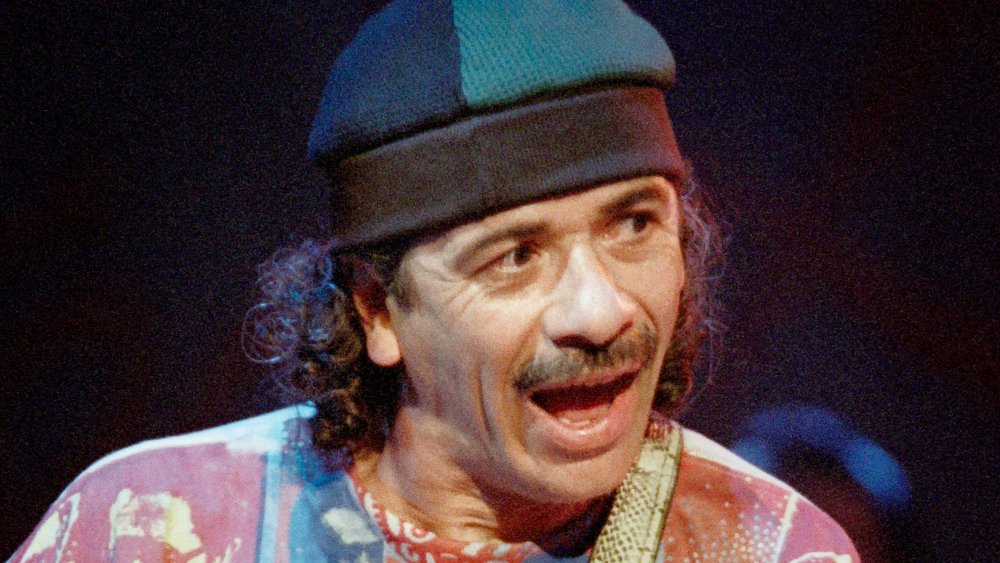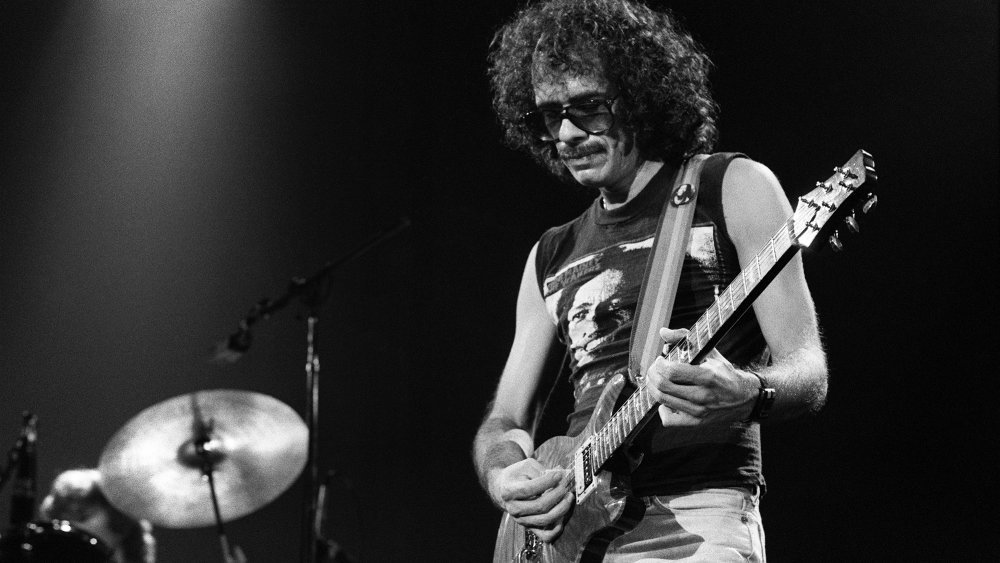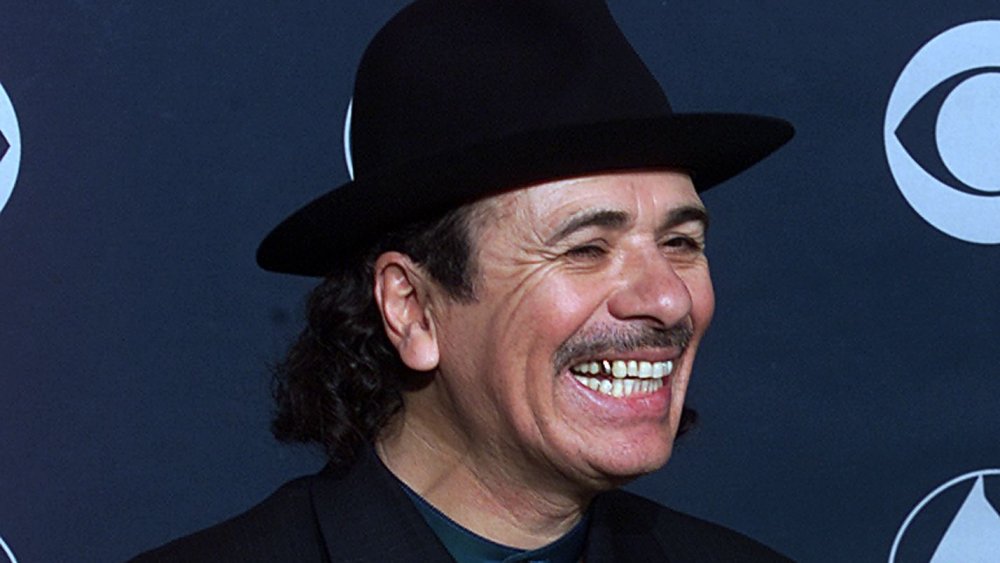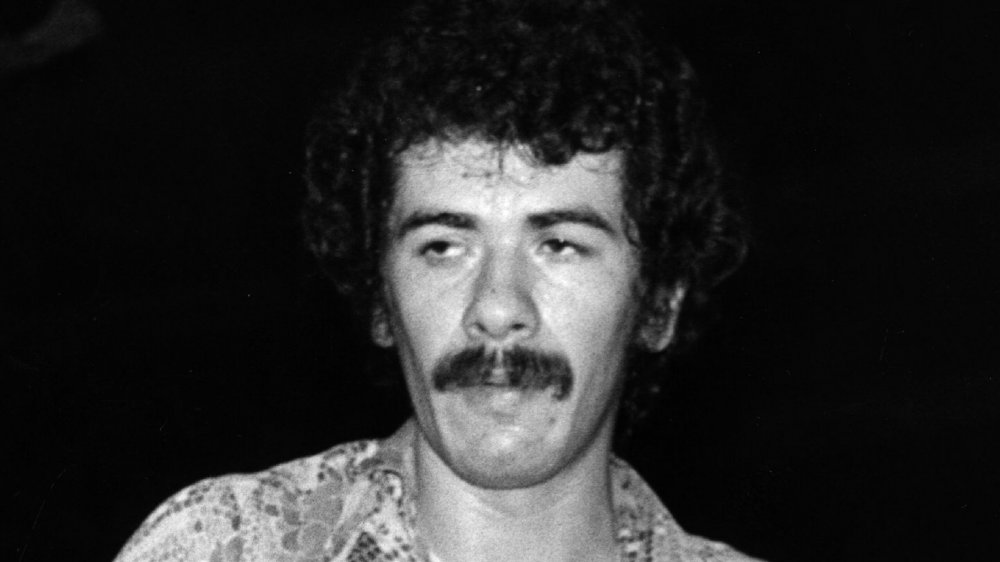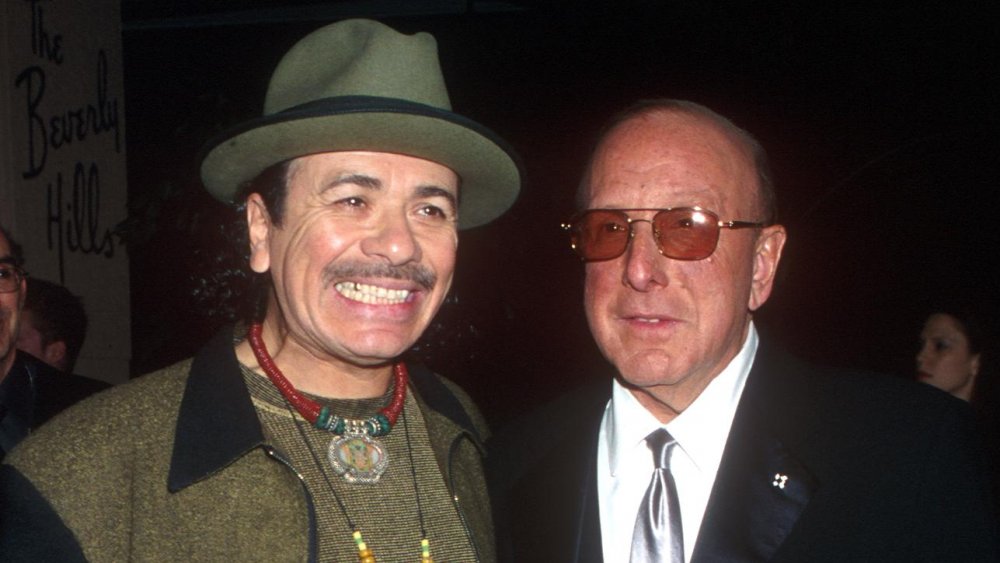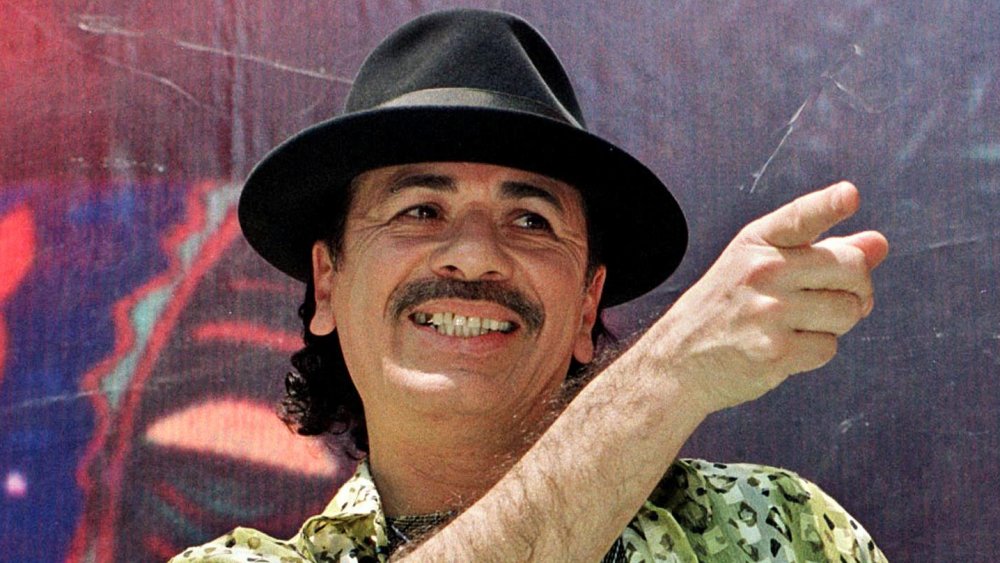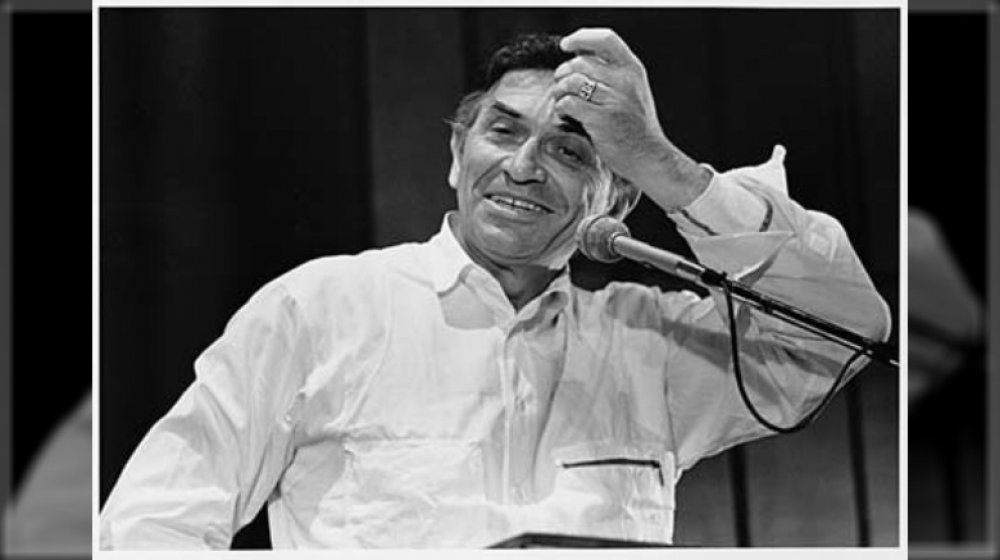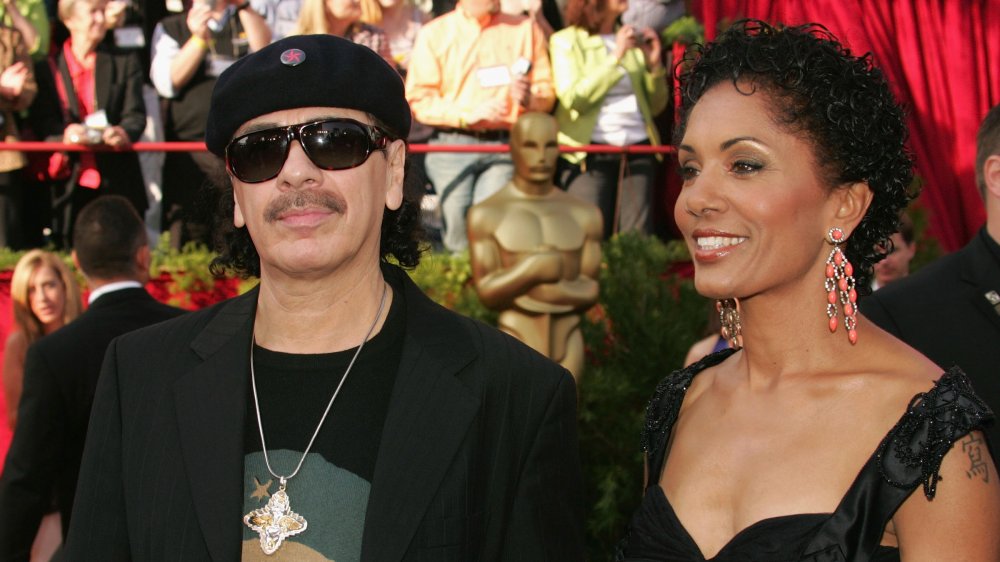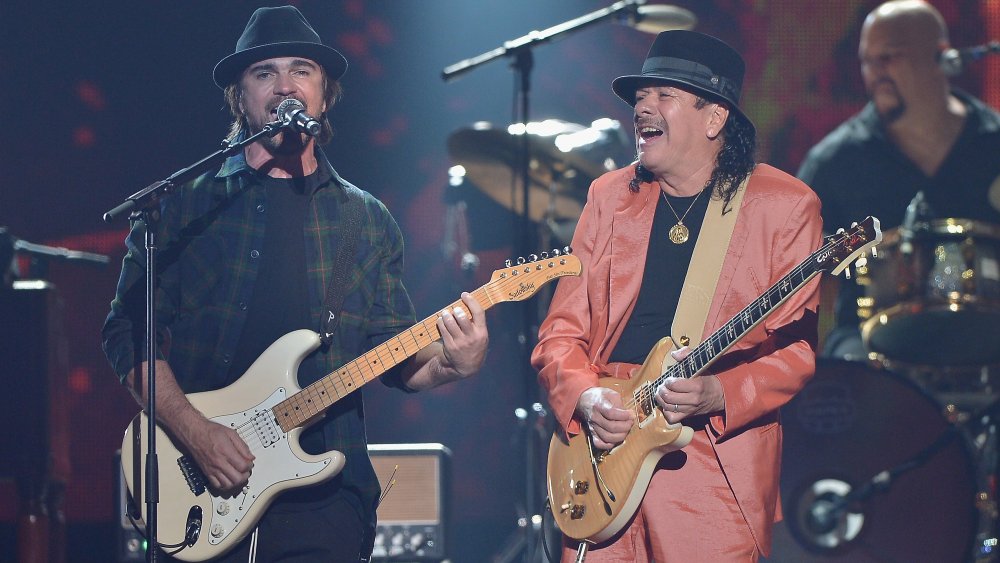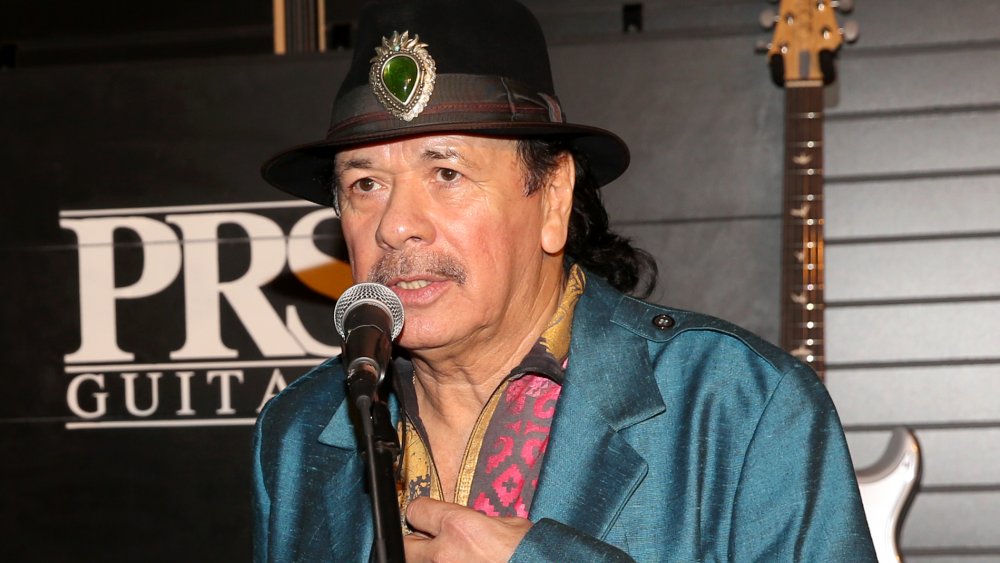The Tragic Real-Life Story Of Carlos Santana
Santana is one of the most enduring bands in rock history, and one of the few eponymous groups not named after its singer. That doesn't matter, because leader Carlos Santana's guitar work is so soulful, distinctive, and innovative. The band's brand of psychedelic rock-meets-Latin jazz took songs like "Evil Ways," "Black Magic Woman," and "Oye Como Va" to the top of the charts (and permanent rotation at rock radio stations).
An iconic performance at Woodstock certainly didn't hurt, and Santana (the man) became an elder statesman of rock 'n' roll and the guitar hero to millions. After fading from mainstream popularity in the '80s and '90s, he stormed back in 1999 with Supernatural, a blockbuster album full of collaborations with up-and-coming musicians. The breakout single was the Santana solo-soaked "Smooth," with matchbox twenty singer Rob Thomas, and according to Billboard, it's the second-most successful single of all time.
However, despite all the success, life hasn't been super easy for Santana. In fact, it's been a long and bumpy road to legendary status for the Rock and Roll Hall of Famer. The man has dealt with everything from a horrible childhood to a pretty terrible health scare, and today, we're taking a look into the unique and tragic story of Carlos Santana.
Carlos Santana lost his innocence early
Born in southern Mexico, Carlos Santana's family moved to Tijuana when he was seven. "It was a shock," Santana recalled to Rolling Stone, and his father put him and his brothers to work, selling gum on the street, shining shoes, and later on, singing Mexican folk songs. Showing an aptitude for the guitar, he soon accompanied his father, a bar musician, to his gigs in dirt-floored saloons where he witnessed such things as a police officer assaulting a prostitute.
By the age of 14, he'd had enough of performing in places that made him feel "really sick," and he went off on his own, earning $9 a week providing musical accompaniment to strippers, working off and on from 4 PM to 6 AM. After playing in such an environment for a while, the once hormonal teen Santana found himself sexually desensitized. "It's just watching an assembly job," he said. "After a while, you learn the most sensual thing is innocence."
It was also during this period of scraping by for a living in Tijuana when Santana says he was abused by an American man, who "almost every other day" would buy young Santana food, clothes, and toys, and then take him into the U.S. for immoral and illegal purposes. The routine abuse ended after the man saw Santana watching a woman through a window and slapped him. As Santana explained, "I looked at him for the first time for who he was: a very sick person."
He ran away after his family betrayed him
Carlos Santana moved with his family to San Francisco when he was a teenager. But he didn't want to move, nor attend what he perceived as a boring American junior high. "I'm hanging around a bunch of older guys and prostitutes, eat when I want, sleep when I want," he told Rolling Stone. "To hang out with a bunch of little kids talking about bulls*** stuff? No way." Santana recalls being constantly angry and upset after the move, even refusing to eat, mad as he was at his family.
It got even worse when some of his money went missing. He'd saved up a small fortune, which he'd subsequently earmarked to pay for immigration papers, only to discover that his mother stole it to pay for his sister's dental work. She left $300 behind, a substantial sum, which Santana planned to use to buy a new Stratocaster guitar he had his eye on. When he asked his mother for the $300, which he'd let her have for safekeeping, she revealed that she'd spent it on rent. Santana was so angry that he took the $20 his mother offered him and went back to Tijuana. He returned to the strip club world, until a year later when his estranged family forcibly retrieved him. "They actually kidnapped me," he said. "Put me in a car."
He contracted tuberculosis
Coming down with a bad case of a potentially fatal disease is terrible. What's worse is getting an illness not seen in large quantities in the United States since the 19th century, and at the same time as what would've likely been a major career breakthrough. In the spring of 1967, Carlos Santana — while fronting the Santana Blues Band and still in high school — had jumped from busking on the streets of San Francisco to opening for the Who. His work impressed the likes of Steve Miller (of the Steve Miller Band) and blues legend Howlin' Wolf, and both had invited the Santana band to open for them on tour.
Sadly, the group didn't get the chance because 19-year-old Carlos Santana was diagnosed with tuberculosis. The young guitarist told Rolling Stone that he spent three months in San Francisco General Hospital, enduring regular penicillin treatments. At one point, he developed an aversion to the drugs, and so medical staff started injecting the healing streptomycin into his rear end. Unable to sit down for weeks, Santana worked with a tutor to finish up his high school education, and he graduated while hospitalized.
Santana's record company blocked his ambitious projects
The first three Santana albums deftly fused jazz, Latin musical forms, and psychedelic rock to create something totally fresh and extremely popular. Santana hit #1 on the album chart and was certified double platinum, while follow-ups Abraxas and Santana III did as well or better, topping the Billboard 200 and going quintuple and double platinum, respectively.
But when it came time to release album number four, Caravanserai, in 1972, Carlos Santana and his bandmates faced resistance from the record label. Far from the smooth, funky, radio-friendly work of the previous albums, it was basically an almost vocals-free experimental jazz record. (According to Rolling Stone, it reflected huge changes in Carlos Santana's life. He'd recently delved heavily into his spiritual side, and he'd almost completely replaced his band.) Columbia Records didn't want to release it, and Santana said in his memoir that company president Clive Davis (pictured) compared it to "career suicide." Nevertheless, it was a top ten hit.
Two years later, after artistic pursuits caused friction with his label, Carlos Santana once again earned the ire of Clive Davis. The live album Lotus, as originally presented, was a three-LP set. Citing concerns that such an expensive endeavor was commercially risky, Columbia only released it in Japan, killing some momentum for Santana and representing another professional setback. Short of buying an expensive import (if they could even find it), fans couldn't buy it in the U.S. until a CD reissue in 1991.
He couldn't record for most of the '90s
The '90s were a commercially and creatively fallow period for Carlos Santana. After the release of his third straight non-gold or platinum album, 1990's Spirits Dancing in the Flesh, Columbia Records — his home label since Clive Davis had signed him in the late 1960s — dropped him. Santana's 1992 record, Milagro, released by Polydor, flopped, and he cut ties with that label, too. At that point, Santana couldn't get a record deal, as he was viewed by the music industry as an old artist past his prime. He had musical ideas, but he couldn't record them anywhere without a contract. "I felt I had a masterpiece of joy in my belly," he told Rolling Stone.
Then around 1997, after the death of his father, musician Jose Santana, Carlos found that even listening to music was too much to bear. "I was numb," he said. After a long period of time passed, he finally felt ready to put himself out there again, and his wife at the time, Deborah King Santana, suggested that in order to do so, he reconnect with Davis, now an executive at Arista Records. Santana and Davis wound up making Supernatural, one of the most significant comebacks in pop music history. A 1999 collection of collaborations between Santana and young pop and rock stars, it initially sold 13 million copies, produced "Smooth" (which spent 12 weeks at #1 on the Billboard Hot 100), and won eight Grammy Awards.
Two close friends died back to back
Carlos Santana probably wouldn't have had the storied, successful career he's enjoyed without a well-timed big break from Bill Graham (pictured). The powerful manager and concert promoter convinced organizers to book a slot for a new San Francisco band he was working with. Obviously, that was Santana, fronted by its 22-year-old virtuoso guitarist. Santana hadn't even released an album yet, but the group gave an electrifying performance, and within the year, the band was topping the charts. Graham and Carlos Santana remained close as both of their legends grew over the decades, up until Graham's tragic death at age 61 in a helicopter accident in Vallejo, California, in November 1991.
A Graham memorial concert was quickly staged in San Francisco, and the bill included Santana, playing through the grief. "They sharpened my tenacity, they sharpened my convictions," Carlos Santana said in a 1992 interview with the Charlotte Observer (via The History Sidebar). The "they" refers to Graham as well as another friend, legendary jazz trumpeter Miles Davis, who died just two months before Graham did.
Carlos Santana and his wife split up after 30 years together
Carlos Santana and the former Deborah King went through a lot of ups and downs together. They married in 1973 and had three children while weathering the '70s highs, '80s lows, and late '90s rebirth of Santana the band. Partners in business as well as life, they opened a small chain of Mexican restaurants, established a charity called the Milagro Foundation, and in 1994, King restructured (and saved) her husband's finances. "I'd probably be a hobo if it wasn't for her," he told Rolling Stone in 2000.
But Santana wasn't always the most faithful husband, as King told the San Francisco Chronicle that after their children were born, Santana "was sleeping with people on the road." After the release of a memoir, Space Between the Stars, that detailed the infidelity, Santana publicly apologized to his wife and kids for his indiscretions. However, a little over two years later, King filed for divorce, citing "irreconcilable differences." Santana moved on, though. In 2010, he proposed to Cindy Blackman, the drummer in his band.
He nearly ended his life on multiple occasions
After Deborah King Santana, Carlos' wife of 34 years, filed for divorce in 2007, the inner life of her husband grew alarmingly dark. Carlos Santana seriously entertained thoughts of ending it all, and in 2008, he told Rolling Stone (via The Gospel Herald) that he'd attempted suicide seven times. Not only did the failure of his long marriage mentally upset the rock legend, but so did lingering thoughts, memories, and feelings of the regular abuse he suffered at the hands of a family friend beginning at the age of ten. Santana credits his spirituality and faith for helping him out of that very low place. "You have to go through the darkest night of the soul to get to the brightest light of the day," he told Plain Truth. He also explained that forgiving his abuser was key to his own personal journey. "Forgiveness, man, forgiveness is incredibly liberating.
If you or someone you know needs help, please call the National Suicide Prevention Lifeline at 1-800-273-TALK (8255).
One of Carlos Santana's bandmates wound up homeless
Marcus "the Magnificent" Malone played percussion in an early incarnation of Santana, the late '60s Santana Blues Band. He left the band in 1969, on account of how he was sentenced to a long spell in the famously brutal San Quentin prison after being convicted of manslaughter. Eventually released, Malone disappeared for years, and Carlos Santana lost touch with his former bandmate and friend, but he put in a concerted effort to locate him in late 2013.
Coincidentally, right around that time, San Francisco Bay Area reporter Stanley Roberts of KRON-TV was investigating a piece about illegal dumping and talked to a homeless man in Oakland claiming to be former Santana collaborator Marcus Malone. Roberts didn't believe him, but he did some research and found that the man's story checked out. Roberts and Santana's management got in touch, and the reporter arranged an emotional reunion of the two musicians. "He's an incredible person that's very significant in my life," Santana told Rolling Stone. "When I saw him my inner-voice was saying, 'Go see him and put an envelope of money in his hand.' I won't tell you how much, but I made sure he was taken care of."
